Circular economy and the wood cycle
ESG activities undertaken by companies, due to the high costs they tend to incur in the short term, often become a trade-off with corporate profits. As asset managers, we therefore face an immediate challenge of balancing our most important mission as asset managers—maximising the profits of our clients—with the creation of societal benefit as required by ESG principles.
Amid this need to simultaneously solve environmental issues and create economic added value, the circular economy has come into our focus for the following reasons: 1) it is not just a theoretical ideal, but it offers a concrete way to generate economic value, 2) it resonates with the younger generation, who will be tasked with solving the societal issues we are facing today and 3) Japanese society has a particularly high affinity with the concept.
The circular economy concept is also in line with our philosophy of “investing in companies that can solve societal issues through pursuing their business goals”. The circular economy embodies a variety of perspectives, among them the promotion of the “wood cycle”.
Chart 1 shows Japan’s roadmap for achieving carbon neutrality by 2050, with 2013 as the base year. In 2013, Japan emitted a net total of 1.24 billion tons of CO2, of which construction activity made up roughly 40%, or 480 million tons. This is not just a phenomenon limited to Japan, as construction consumes 45% of the world’s resources with most buildings incinerated or sent to landfills after they are torn down. Reducing the burden on the environment from construction is clearly an issue that needs to be tackled globally.
Chart 1: Japan’s roadmap for achieving carbon neutrality by 2050
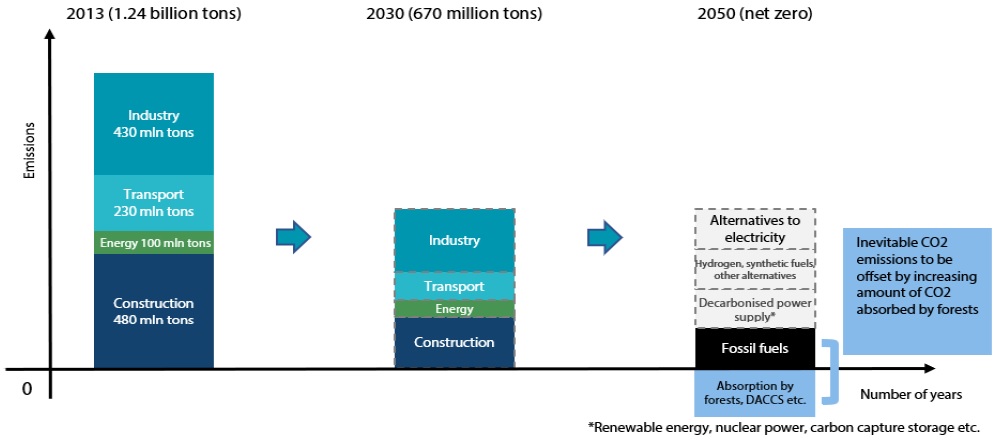
Source: Sumitomo Forestry “Long-Term Vision for Decarbonization”
Forest resources can be used to cut overall CO2 emissions and reduce construction waste. Forests in Japan differ in characteristic from those found in the rest of the world, and each present different challenges to the utilisation of forest resources.
Differing challenges facing utilisation of forest resources
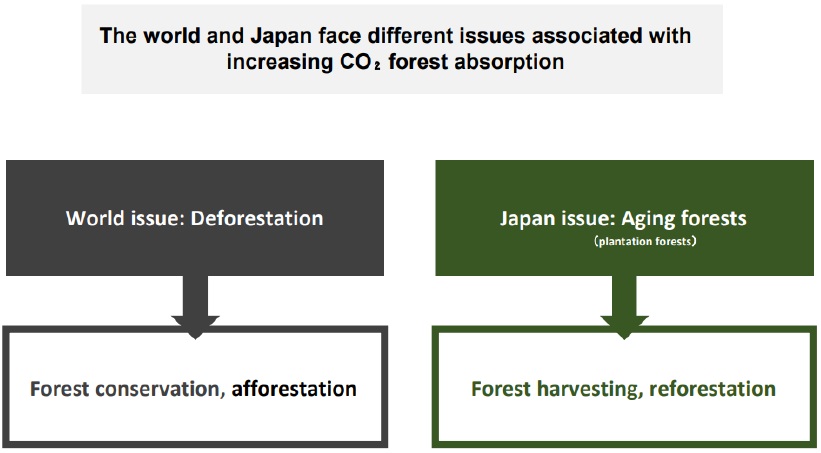
Source: Sumitomo Forestry “Long-Term Vision for Decarbonization”
Challenges facing global forests
A big challenge facing global woodlands is the rapid pace of deforestation. Chart 2 shows the state of the world’s forests over the past 30 years; it is estimated that a net 10 million ha of forest has been lost worldwide in the decade since 2010.
Chart 2: Annual rate of forest expansion and deforestation, 1990–2020
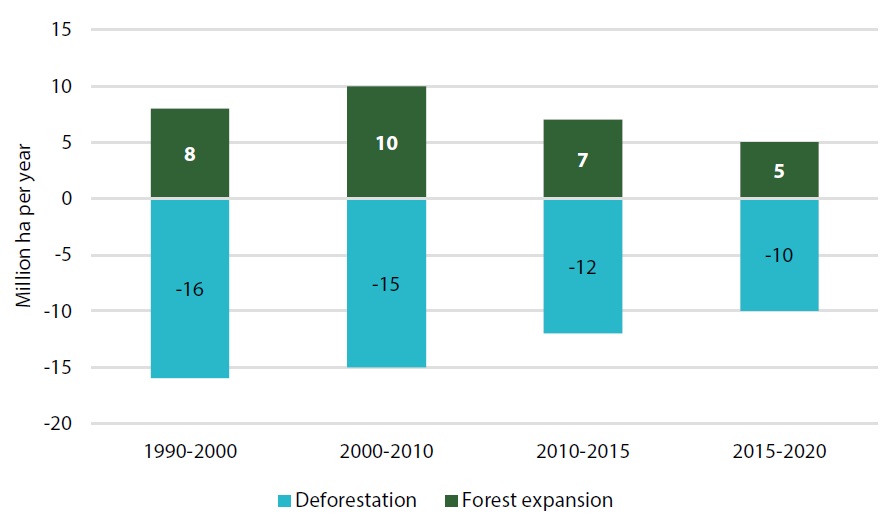
Source: Food and Agriculture Organization "Global Forest Resources Assessment 2020"
Deforestation is driven by poorly planned development, rampant meat and soybean production, increasing demand for cultivated land and wildfires. The wildfire which raged across southeast Australia in 2019 killed much wildlife including tens of thousands of koalas and devastated forested areas larger than Portugal. Australia’s forests are currently being lost at twice the pace of the 2000-2010 period; this example alone shows the importance of halting deforestation and pivoting towards conservation and reforestation.
Challenges facing Japanese forests
Japanese forests face two challenges: the first is their deteriorating ability to absorb CO2 due to aging and the second is the low turnover of forest resources. Forests have covered about 70% of Japan for the past 50 years. In land area, Japan is the 12th largest among the 34 OECD countries. But it is also the third most forested OECD country, and its forests are in relatively good condition. Despite such advantages, Japan’s forests face a serious challenge as aging growth reduces their ability to absorb CO2.
In general, younger trees can absorb more CO2 and a cycle maintained by appropriate logging to utilise forest resources and replanting is considered a prerequisite to maintain healthy forests.
Chart 3 shows how much CO2 trees can absorb during their life cycle, using Japanese cedar and Japanese cypress, two typical conifers found in Japan’s forests, as examples. The chart shows that 10- to 20-year-old trees absorb the most CO2, with the absorption amount then gradually decreasing until by the time they are 50 years old or older, when they are only absorbing half the amount of CO2 compared to their peak. The data illustrate the fact that from a CO2 absorption perspective, forests should be composed primarily of younger trees, with older trees utilised as “useful forest resources” that can be converted into various consumer items. The formation of a cyclical forest model/wood cycle that involves 1) replanting to increase younger trees, 2) using older trees as construction material and furniture and 3) sequestration of CO2 thereby becomes a key point in utilising forest resources.
Chart 3: Changes in CO2 absorption capabilities of cedar and cypress by age
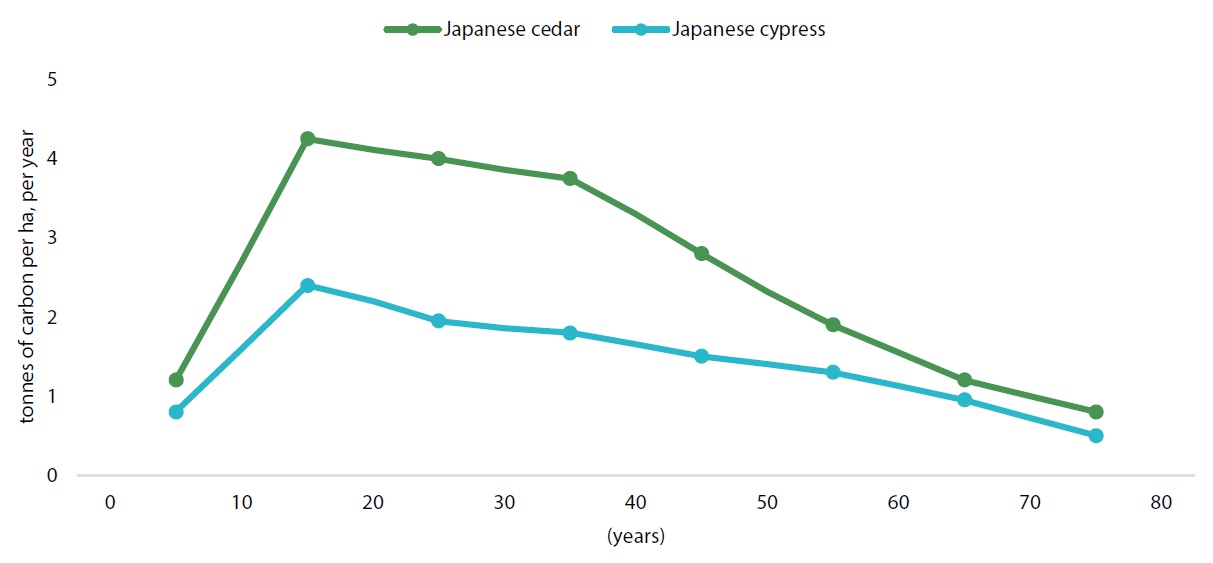
Source: Learning Museum of the Forest and Forestry (https://www.shinrin-ringyou.com/ondanka_boushi/tanso_kyusyu.php)
Of Japan’s 25 million ha of forested areas, planted forests account for 10.3 million ha, or 40%, with most consisting of conifers such as Japanese cedar and Japanese cypress. These trees are high in average age, raising concerns that planted forests will absorb less CO2 in the future. Chart 4 shows the change in age composition of Japan’s planted forests. Following the end of World War 2, Japan actively increased its planted forests to revive the country devastated by war and provide material for its rebuilding. Chart 4 compares the age composition between 1966 and 2017; trees younger than 10 years made up the majority of forests half a century ago, but they have since aged and currently more than half of the forests consist of trees that are older than 50 years. From an economic perspective, these older trees are ready to be harvested and utilised as environmental material after absorbing large amounts of CO2 during their lifetime. The reality, however, is that harvesting is not conducted on an ample scale due to insufficient infrastructure and dwindling numbers of forest workers. For example, only 2% of cedars are harvested and replanted. As a result, Japan’s wood self-sufficiency rate remains at 42% despite the abundant resources available (the US and Australia’s self-sufficiency rates exceed 90%). The recent surge in lumber prices (described by some as the “wood shock”) amid global inflation on a scale unseen in many decades is still fresh in memory. Japan, unlike many other countries, has the capacity to counter such price shocks with practical solutions.
Chart 4: Age composition of Japan’s planted forests
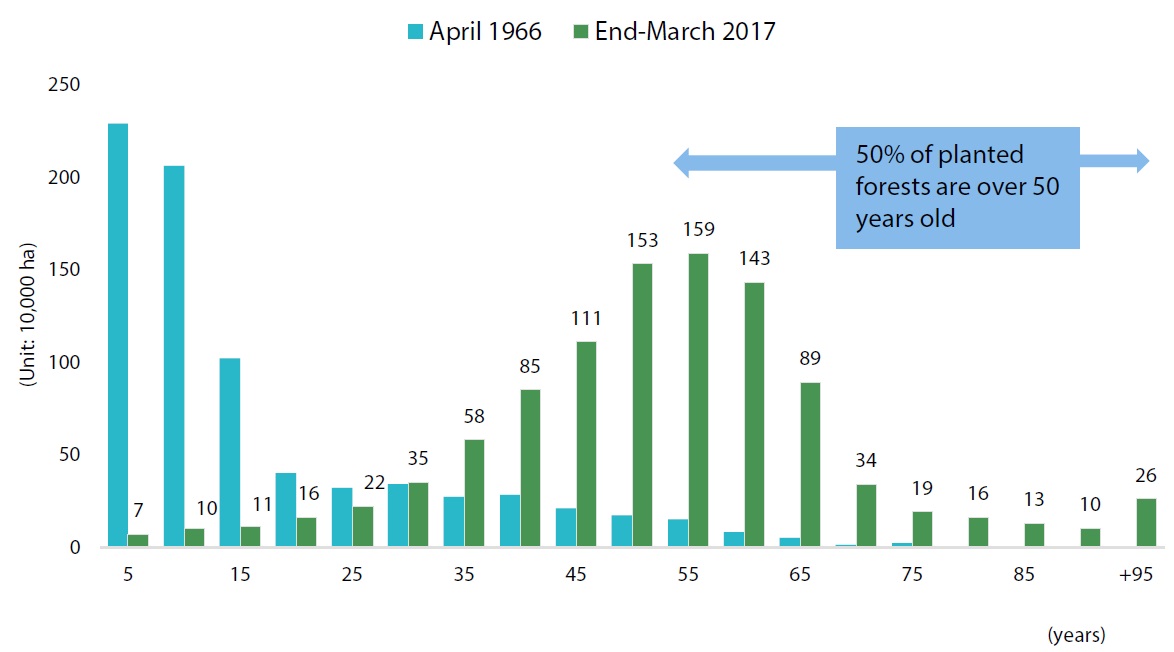
Source: Ministry of Agriculture, Forestry and Fisheries “Annual Report on Forest and Forestry in Japan” (FY 2018)
In Japan, trees planted in the past have now matured and present a valuable environmental asset, but at the same time their CO2-absorbing capacity continues to diminish. In order to turn this situation around, it will be important to harvest and utilise mature trees which have already absorbed enough CO2 and allow for rejuvenation through reforestation all the while protecting the ecosystem. Seen from a different viewpoint, Japan boasts a wealth of forest resources unseen anywhere else that can store CO2.
Utilising wood for long-term carbon storage
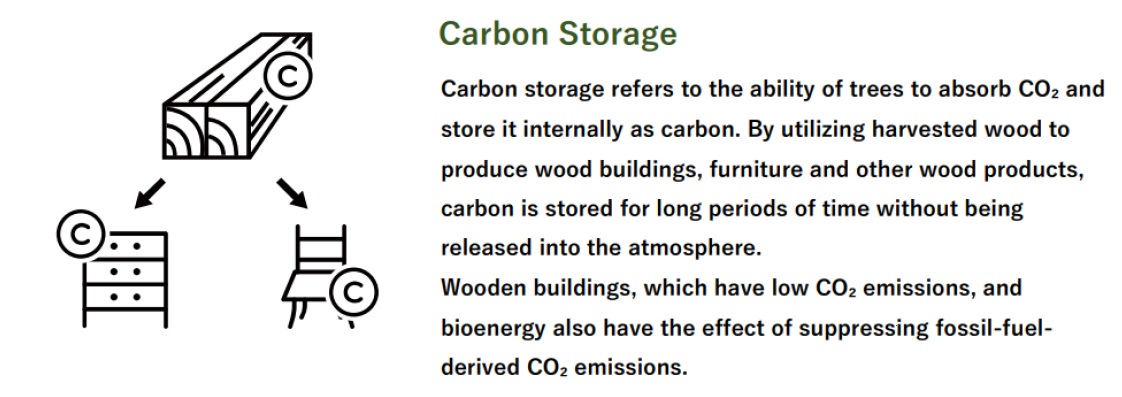
Source: Sumitomo Forestry “Long-Term Vision for Decarbonization”
The illustration below shows the carbon circulation process and storage period. Through photosynthesis trees break down water, emitting oxygen while producing nutrients for themselves. Trees use CO2 for photosynthesis, and CO2 is then stored within the trees. This process and others that involve sequestration is called “carbon storage”. When trees wilt and die, or are burned, the CO2 they store is quickly released into the atmosphere. However, the carbon storage period can be extended if mature trees are harvested and used as furniture and as alternative construction material in areas in which wood has not been traditionally used, such as high rises. Such uses will increase the carbon storage capacity of society as a whole and make a significant contribution towards decarbonisation.
Carbon circulation process

Source: Sumitomo Forestry “Long-Term Vision for Decarbonization”
The following diagram summarises the issues that Japanese and global forests face and the pathways towards potential solutions.

Source: Sumitomo Forestry
Stopping deforestation is the key global issue, and the conservation and maintenance of forests need to begin as soon as possible. For this to happen, contributions will be necessary from professional organisations with expert knowledge and experience in forestry and ecosystem conservation. We believe that an effective solution is to incorporate such professional organisations in constructing an all-encompassing business solution involving the creation of funds jointly managed by governments and local communities, consulting activity and forest management utilising technologies such as drones and satellites.
For Japan, the key issue is rejuvenating aging forests. One effective solution would be to set up a wood cycle with appropriate harvesting and replanting and where the harvested timber is actively utilised in construction and other purposes. As mentioned earlier, trees absorb the most CO2 when they are 10 to 20 years old. Beginning the rejuvenation of Japanese forests now ahead of the carbon net zero target year of 2050—and also before the milestone year of 2030—could yield some visible results.
The resulting reduction in overall CO2 emissions and industrial waste, in addition to benefits to consumers and corporations from the cost reduction effect, will have a significantly positive impact on society, for example, by improving the mental wellbeing of individuals. This, in our view, is a particularly promising model that meets both ESG-derived demand to increase societal benefit and the need to generate economic profit.
The Japanese market is small relative to that of the European Union and as such, Japan may not be able to exert global influence when it comes to the formation of environmental rules and regulations. On the other hand, Japan could still play a significant global role in the creation of environmental models as it can lead by example in tackling issues common to many other countries. This is because generations-old systems that efficiently link resource-recycling to economic benefits and sustainability have been in existence long before the environment became a prominent cause for concern in Europe, and these models indigenous to Japan contain plenty of ideas that other countries can utilize in tackling environmental issues. We hope to introduce such environmental system role models in future editions of Japan Value Insights.
Many Japanese companies have adopted such environmental systems in their business plans in a bid to increase their financial and non-financial value both in Japan and abroad. One such company is Sumitomo Forestry Group, which owns and manages about 280,000 ha of forests in Japan, Southeast Asia and Oceania. What is unique about the company is the way in which it fully encompasses fields related to forestry; its operations include forest management, the processing and distribution of lumber, construction of wooden buildings and biomass power generation.
Sumitomo Forestry has divided its decarbonisation business into three initiatives, aiming for their expansion with 2030 set as their milestone year. The first initiative focuses on achieving growth through the expansion of its “cyclical forestry business”. This is an ambitious undertaking attempting to achieve both decarbonisation and maintenance of business by expanding CO2-absorbing protected forests while at the same time accelerating the reforestation of forests intended for economic benefit (“working forests”) by harvesting trees which store ample amounts of CO2. The company plans to set up a global forest fund to meet its goal, intending to increase forests under their management to 500,000 ha by 2030 from the current 280,000 ha. The second is the “promote wood change” initiative. Sumitomo Forestry aims to establish timber industrial complexes in Japan to raise wood manufacturing productivity, increase price competitiveness of Japanese timber and create job opportunities for local foresters. The goal is to boost Japan’s wood self-sufficiency rate, currently at around 42%, and increase carbon storage. The third initiative is the “standardize decarbonized design”, which strives to reduce CO2 emissions from construction and other everyday activities by popularising decarbonised building construction through the promotion of wood materials, net-zero energy buildings (ZEB) and wooden offices.
As of 2020, Sumitomo Forestry’s annual Scope 1 and 2 CO2 emissions amount totalled 370,000 tons; as the forests they own and manage are able to absorb 780,000 tons of CO2 per year, the company is already net carbon negative.
Summary
The circular economy concept has increased in importance as investors face the task of simultaneously solving environmental issues and creating economic added value. The circular economy embodies a variety of perspectives, notably the wood cycle, which involves the utilisation and regeneration of forests. Stopping deforestation is the key global issue, while regenerating aging woodlands is the challenge facing Japanese forests. Resolving these issues will allow forests to be utilised as a source of economic wealth and also contribute to the net reduction of CO2 emissions.
Reference to individual stocks is for illustration purpose only and does not guarantee their continued inclusion in the strategy’s portfolio, nor constitute a recommendation to buy or sell.




